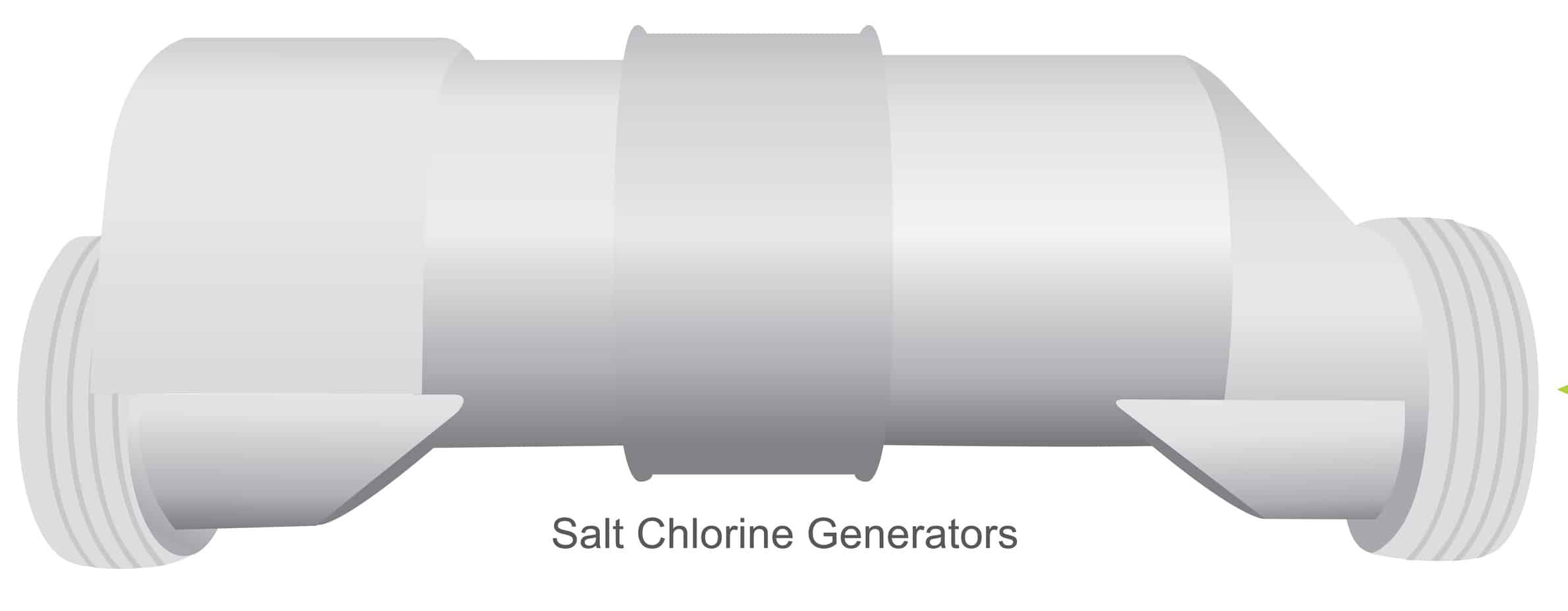A salt cell is a crucial component of a salt water chlorinator system. It’s responsible for producing the chlorine that keeps your pool water clean and clear. It is a hard plastic tube that fits into your pool plumbing and has metal plates inside that when electrified, convert liquid salt into chlorine to sanitize your pool water.
A typical salt chlorination system has three main components:
- Salt cell – The hard plastic tube that water flows through and where chlorine is produced.
- Salt chlorinator control box – Controls the chlorinator system and features the buttons and settings you can adjust. The brains of the operations, basically.
- Water flow meter – Is built inside the pipes before the salt cell to alert you when water flow is too low. It will automatically shut down the chlorinator to protect the cell from burning out, until proper water flow is restored.
Below we’ll discuss the salt cell specifically and how it works.
Saltwater pool salt cell overview
The salt cell is a hard plastic tube that screws into the existing pool plumbing. It remains in place throughout the pool season but should be removed and brought indoors during the winter particularly if you live in a cold winter environment.
Here’s how it works:
- Salt water flows into the salt cell and passes through a series of metal plates.
- As the water flows over the plates, an electrical current is passed through the salt cell. NOTE: The plates are only electrified when the pump is running and the chlorinator is running. You can run the pump but the chlorinator won’t need to run 100% of the time.
- This electrical current causes a chemical reaction that converts salt (NaCl) into chlorine (Cl2).
- The newly produced chlorine is then dispersed into the pool water, where it sanitizes the water by killing bacteria, algae, and other contaminants.
- Once the chlorine has done its job by killing contaminants, it reverts back to salt and the process starts over. You will need to add salt to the pool from time to time as salt levels do drop for several reasons.
Now, let’s take a look at a table with various specifications for salt cells.
Salt cell specifications and explanation
Salt cells are typically sold with a similar main function (i.e. convert salt to chlorine!) but the distinguishing feature is usually the daily chlorine producing capacity and how much chlorine it can produce during its total lifespan.
The clorinator system itself will provide more functionality such as pump timer, live salt level reading and as we’ll see below, the ability to automatically clean your salt cell which is a great time-saving feature.
| Specification | Explanation |
|---|---|
| Cell type | There are two main types of salt cells: self-cleaning and manual-cleaning. Self-cleaning cells use reverse polarity to clean themselves, while manual-cleaning cells require periodic cleaning with acid. |
| Cell size | The size of the cell determines how much chlorine it can produce. It’s important to choose a cell size that’s appropriate for your pool’s volume. Salt cell models are typically sold with clear water volume limits such as 40,000 gallons, 25,000 gallons, 15,000 gallons, etc which correlates to the total water volume of your pool. |
| Life expectancy | Salt cells have a limited lifespan and will eventually need to be replaced. The life expectancy of a salt cell depends on various factors such as usage, water chemistry, and maintenance. Some Hayward brands advertise 725 lbs of total chlorine production during a cell’s lifespan. |
| Chlorine output | This refers to how much chlorine the cell can produce per hour or day. The output should be matched to the size of your pool to ensure adequate sanitation. |
| Voltage | The voltage required by a salt cell varies depending on the model. It’s important to ensure that your chlorinator is compatible with your pool’s electrical system. Chlorinators are generally hardwired but you might find a plug-in model too. |
| Warranty | Most salt cells come with a warranty that covers defects or premature failure. It’s important to choose a cell with a warranty that’s appropriate for your needs. |
Will a bigger capacity salt cell last longer?
A salt cell is marketed and sold by its capacity in water volume. A 40,000 gallon salt cell would at best be suitable for a 40,000 gallon pool. However, it’s generally suggested to oversize your salt cell by 1.5 – 2 times. So if you own a 25,000 gallon pool, buying a 40,000 gallon salt cell can be a good idea.
The size of a salt cell for a saltwater pool is primarily determined by the size of the pool and the expected chlorine demand. A larger salt cell can produce more chlorine, but it doesn’t necessarily mean it will last longer than a smaller one.
The lifespan of a salt cell depends on various factors such as usage, water chemistry, and maintenance. If a larger cell is producing more chlorine to meet the demands of a larger pool, it may have a shorter lifespan than a smaller cell that’s producing less chlorine for a smaller pool.
In general, salt cells have a limited lifespan and will eventually need to be replaced regardless of their size. The life expectancy of a salt cell is usually determined by the manufacturer and can range from 3-7 years, depending on the model and usage.
But oversizing your salt cell and buying a model that has a larger capacity than your pool’s water volume is a smart idea.

